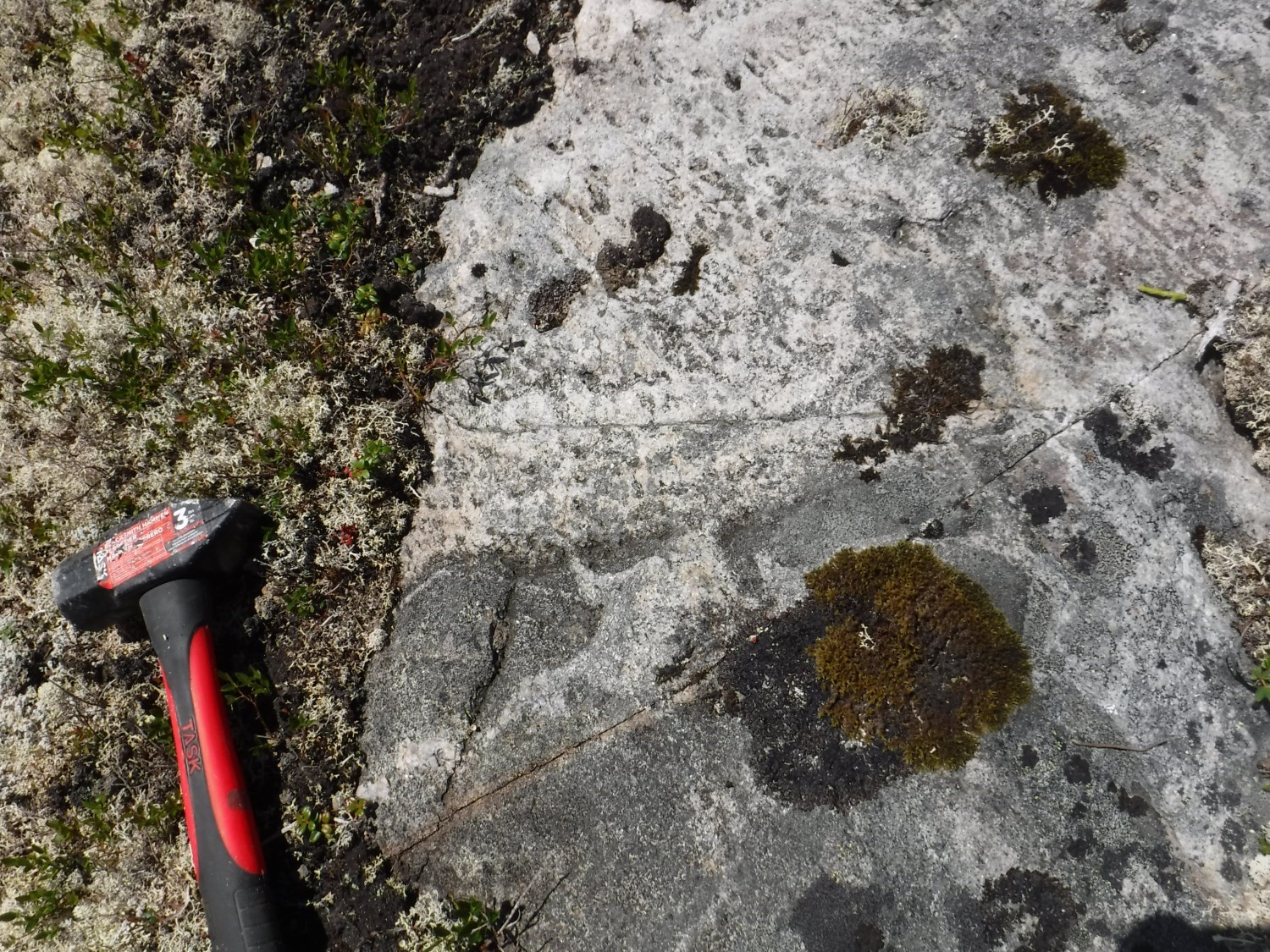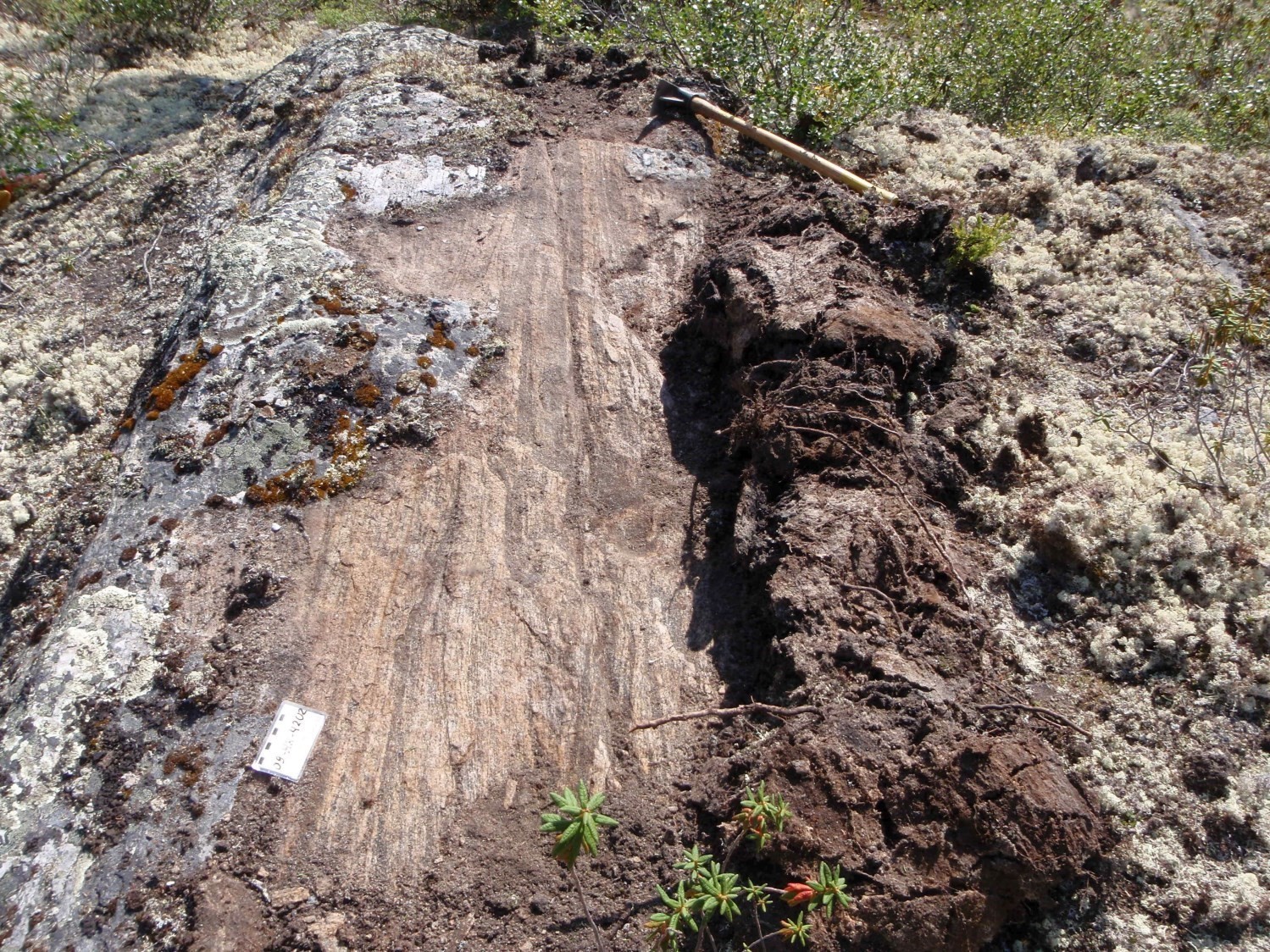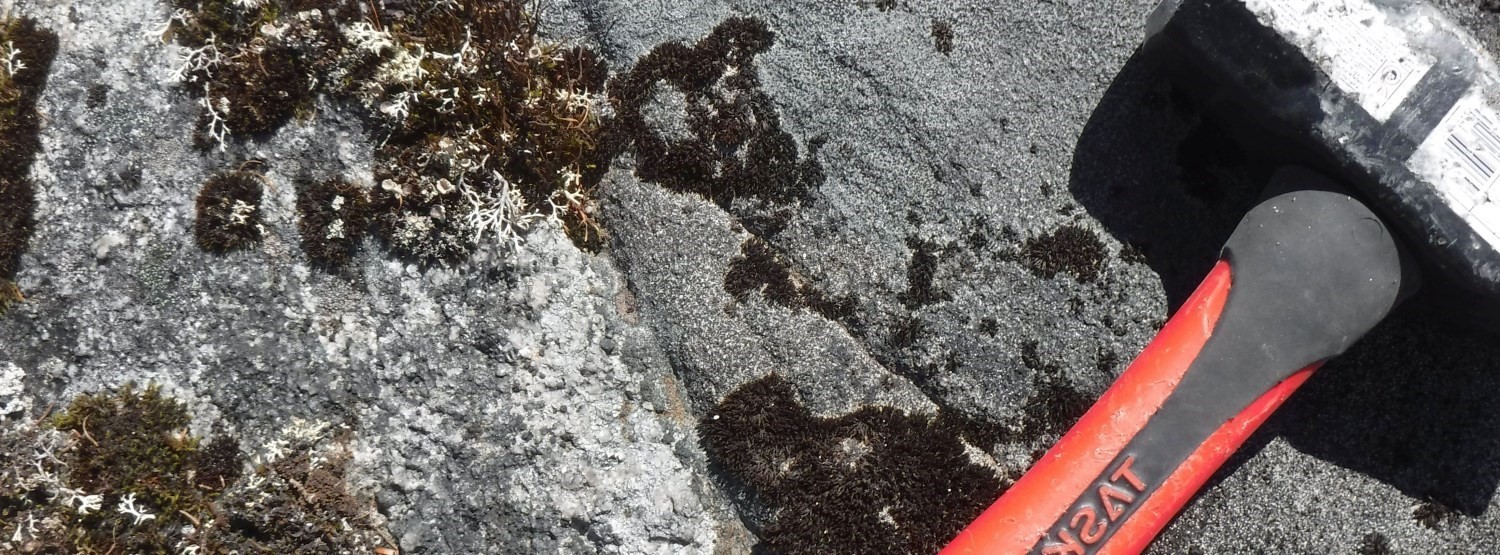
DISCLAIMER: This English version is translated from the original French. In case of any discrepancy, the French version shall prevail.
| Author: | Hammouche et al., 2012 |
| Age: | Neoarchean |
| Stratotype: | None |
| Type area: | Bonaventure Lake area (NTS sheets 23P04 and 23I13) |
| Geological province: | Churchill Province |
| Geological subdivision: | Baleine Lithotectonic Domain |
| Lithology: | Gneiss |
| Category: | Lithodemic |
| Rank: | Complex |
| Status: | Formal |
| Use: | Active |
None
Background
The term “Griffis Gneiss” was introduced by Hammouche et al. (2011) to refer to a package of Archean gneiss found within the “Rachel-Laporte Zone”. This unit corresponds to Unit 1 of Donaldson (1966), consisting of gneiss and migmatite, and units 5b and 6 of Farhig (1964), consisting respectively of hornblende orthogneiss and biotite orthogneiss. As part of a synthesis of the Southeastern Churchill Province (SECP) (Lafrance et al., 2018), the unit was renamed “Griffis Complex” by Lafrance et al. (2020) to comply with the North American Stratigraphic Code. Since Lafrance et al. (2018) have also identified new lithotectonic domains within the SECP, the Griffis Complex is now included in the Baleine Lithotectonic Domain.
Description
The Griffis Complex contains various lithological units, the main of which are tonalite, tonalitic gneiss, paragneiss, gabbro and gabbronorite.
Tonalite is whitish, homogeneous, medium grained and regularly contains biotite laminae resembling schlierens. These could be mobilisate derived from the melting of gneiss (and paragneiss), but field relationships cannot confirm this. However, the tonalite’s appearance is more heterogeneous at the edge of mafic intrusions. In addition to centimetric to metric enclaves of gabbro and gabbronorite, it contains numerous biotite laminae giving it a coarsely banded appearance. Tonalite is composed of 5-10% ferromagnesian minerals, mainly biotite and epidote, with local hornblende. In thin sections, the rock is partially recrystallized and shows partial replacement of plagioclase by scapolite or a muscovite-carbonate-epidote assemblage. Accessory minerals are chlorite, sphene, opaque minerals and apatite.
Tonalitic gneiss was observed in the Bonaventure Lake area (Hammouche et al., 2011). It is beige, granoblastic, even grained, medium grained and shows banding enhanced by the presence of biotite laminae. It contains low amounts of K-feldspar (2-3%), biotite (>5%) and locally amphibole, epidote, magnetite and muscovite. Zoisite, apatite and sphene are present in minor amounts. Hercynite has also been observed in thin sections. Centimetric to decimetric layers of fine to medium-grained dark green amphibolite are interstratified in the gneiss.
Paragneiss is highly migmatized. The paleosome is light grey, fine grained and rich in K-feldspar. The leucosome is whitish, medium grained, mostly tonalitic in composition and forms centimetric bands. It is leucocratic with <5% biotite that marks foliation. Migmatized paragneiss contains 7-12% millimetric to centimetric garnet rich in quartz inclusions. Accessory minerals are sparse and represented by muscovite, opaque minerals and apatite.
Although they occur as enclaves in tonalite, gabbro and gabbronorite also form metric to decametric layers possibly representing larger enclaves. Mafic rocks are foliated, medium grained and contain nearly 50% ferromagnesian minerals. Gabbro is amphibolitized and contains mainly millimetric amphibole clusters (clinopyroxene pseudomorphs). The margin of mafic enclaves is composed of hornblende, while the core is formed of acicular tremolite intergrown crystals or actinolite-plagioclase symplectites. Clinopyroxene relics are locally preserved. Intergrown biotite crystal clusters are also observed near amphiboles. Gabbronorite is granoblastic, even grained and contains coarser-grained enderbite (hypersthene tonalite) bands. Ferromagnesian minerals are hornblende, clinopyroxene and orthopyroxene in similar proportions. Hornblende is replacing pyroxenes. Accessory minerals observed in mafic layers are opaque minerals, apatite and garnet.
Thickness and distribution
The Griffis Complex forms an N-S-oriented, ~50 km-long block (423 km2) at the SW end of the Baleine Lithotectonic Domain (sheets 23P04 and 23I13).
Dating
A gneiss sample collected in the Bonaventure Lake area (2009-CL-3269) yielded an initial age of ~2789 Ma, interpreted as the crystallization age, and a second age of ~2634 Ma, representing an age of remobilization or metamorphism (David et al., 2011). The Archean age is similar to that of several tonalite units in the Superior Province, but it is also similar to those obtained in gneiss of the Ungava Complex. The age of remobilization or metamorphism is comparable to metamorphic ages obtained in rocks of the Ashuanipi Subprovince (2641-2632 Ma; Percival et al., 1992; Parent, 1998; Wodicka et al., 2009) forming part of the Archean basement west of the New Quebec Orogen (NQO). Based on U-Pb data obtained from zircons, the Griffis Complex does not appear to have recorded metamorphism related to the NQO (1820-1770 Ma; Wardle et al., 2002).
| Unit | Sample Number | Isotopic System | Mineral | Crystallization Age (Ma) | (+) | (-) | Metamorphic Age (Ma) | (+) | (-) | Reference(s) |
| nAgrf | 2009-CL-3269 | U-Pb | Zircon | 2789 | 17 | 5 | 2633.7 | 2 | 2 | David et al., 2011 |
Stratigraphic Relationship(s)
The Griffis Complex is located in the SW portion of the Baleine Lithotectonic Domain. Since there are not many outcrops, it is presumed to be in contact with the Labrador Through to the SW and the Rachel-Laporte Domain to the NE (Donaldson, 1966). It is cut by intrusions of the Gamelin Enderbite.
Paleontology
Does not apply.
References
Publications available through SIGÉOM Examine
DAVID, J., MCNICOLL, V., SIMARD, M., BANDYAYERA, D., HAMMOUCHE, H., GOUTIER, J., PILOTE, P., RHEAUME, P., LECLERC, F., DION, C., 2011. Datations U-Pb effectuées dans les provinces du Supérieur et de Churchill en 2009-2010. MRNF; RP 2011-02, 37 pages.
DAVID, J., MCNICOLL, V., SIMARD, M., BANDYAYERA, D., HAMMOUCHE, H., GOUTIER, J., PILOTE, P., RHEAUME, P., LECLERC, F., DION, C., 2012. U-PB DATING IN THE SUPERIOR AND CHURCHILL PROVINCES IN 2009-2010. MRNF; RP 2011-02(A), 2 pages.
HAMMOUCHE, H., LEGOUIX, C., GOUTIER, J., DION, C., PETRELLA, L., 2011. GEOLOGIE DE LA REGION DU LAC BONAVENTURE. MRNF; RG 2011-03, 37 pages, 1 plan.
LAFRANCE, I., CHARETTE, B., VANIER, M.-A., 2018. Sud-est de la Province de Churchill, Nunavik, Québec, Canada: synthèse de la géologie. MERN; BG 2018-12
LAFRANCE, I., VANIER, M.-A., CHARETTE, B., 2020. Domaine lithotectonique de Baleine, sud-est de la Province de Churchill, Québec, Canada: synthèse de la géologie. MERN; BG 2020-07, 4 plans.
PARENT, M., 1998. GEOCHRONOLOGIE U-PB DU PROJET MOYEN-NORD, PHASE II. rapport statutaire soumis au gouvernement du Québec; GM 59904, 63 pages.
WODICKA, N., LAMOTHE, D., LECLAIR, A., 2009. GEOCHRONOLOGIE U-PB DU PROJET ASHUANIPI. COMMISSION GEOLOGIQUE DU CAN, RESSOURCES NATURELLES CANADA, MRNF; MB 2009-03, 21 pages.
Other publications
DONALDSON, J.A., 1966. Marion Lake map-area, Quebec – Newfoundland (23I/13). Geological Survey of Canada, Memoir 338, 85 pages (2 sheets). https://doi.org/10.4095/123900
FARHIG, W.F., 1964. Geology, Griffis Lake, New Quebec / Géologie, Griffis Lake, Nouveau Québec. Geological Survey of Canada, « A » Series Map 1121A, 1 sheet. https://doi.org/10.4095/107788
PERCIVAL, J.A., MORTENSEN, J.K., STERN, R.A., CARD, K.D., BÉGIN, N.J., 1992. Giant granulite terranes of northeastern Superior Province: the Ashuanipi complex and Minto block. Canadian Journal of Earth Sciences; volume 29, pages 2287-2308. https://doi.org/10.1139/e92-179
WARDLE, R.J., JAMES, D.T., SCOTT, D.J., HALL, J., 2002. The southeastern Churchill Province: synthesis of a Paleoproterozoic transpressional orogen. Canadian Journal of Earth Science; volume 39, pages 639-663. https://doi.org/10.1139/e02-004
Suggested Citation
Ministère de l’Énergie et des Ressources naturelles (MERN). Griffis Complex. Quebec Stratigraphic Lexicon. https://gq.mines.gouv.qc.ca/lexique-stratigraphique/province-de-churchill/complexe-de-griffis_en [accessed on Day Month Year].
Contributors
|
First publication |
Isabelle Lafrance, P.Geo., M.Sc. isabelle.lafrance@mern.gouv.qc.ca (redaction) Mehdi A. Guemache, P.Geo., Ph.D. (coordination); Pierre Lacoste, P.Geo., M.Sc. (critical review); Simon Auclair, P.Geo., M.Sc. (editing); Céline Dupuis, P.Geo., Ph.D. (English version); Nathalie Bouchard (HTML editing). |
29 janvier 2020



